How Mexico's Musical Past Finds Its Voice in the Present
Unlocking Mexico's musical secrets, “The Past That Sounds and Resonates” revives forgotten treasures, recording 22 pieces dating back to 1660. This project, a harmonious blend of history and melody, safeguards cultural heritage for future generations.

In the clandestine alcoves of historical archives, often nestled within the grandeur of cathedrals, lie musical treasures that have withstood the test of time, yet remain unknown to the majority. Lucero Enríquez Rubio, a sharp-minded researcher at the Institute of Aesthetic Research (IIE) of the UNAM, has embarked on a mission to unearth, preserve, and propagate these forgotten melodies before they vanish into the abyss of obscurity.
In a recent interview, Rubio emphasized the importance of documenting these musical relics, weaving a sonic tapestry that encapsulates Mexico's rich cultural heritage. Through the ingenious project, “The Past That Sounds and Resonates,” spearheaded by the Music Seminar of New Spain and Independent Mexico (Musicat), in collaboration with the Grammy Latin Cultural Foundation, 22 timeless pieces spanning various genres and epochs have been meticulously recorded across the nation.




